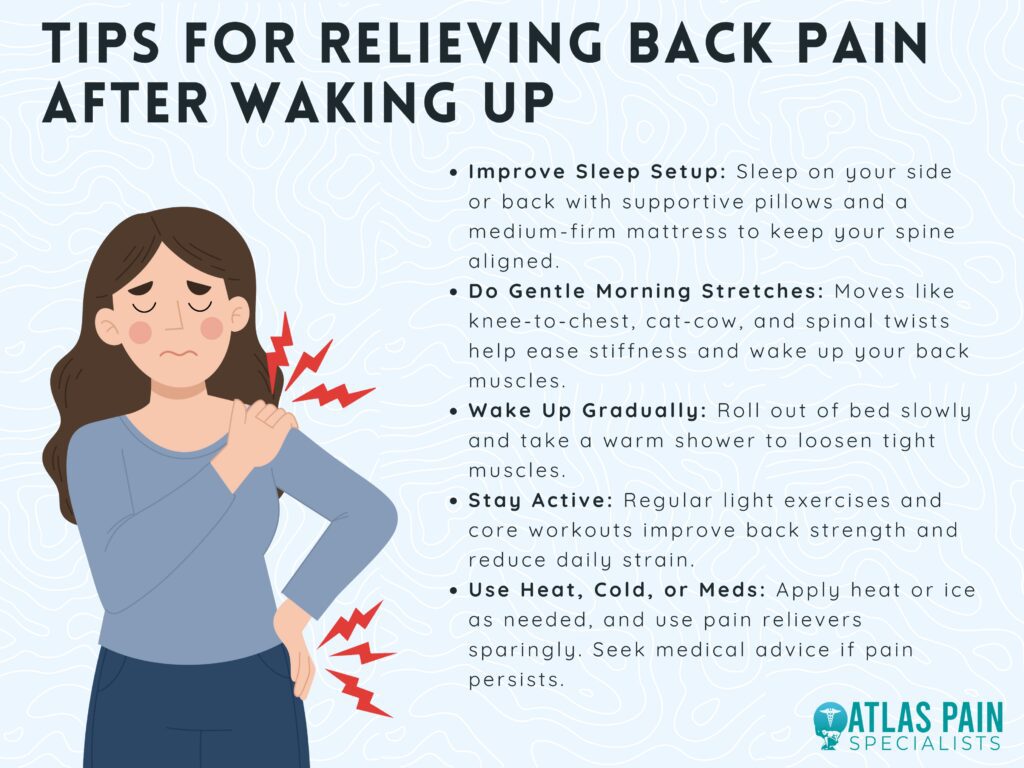

Tips for Relieving Back Pain After Waking Up
Waking up with back pain is a common struggle that can affect your entire day. Whether it's from poor sleep posture, sedentary habits, or even unexpected causes like constipation or ill-fitting bras, morning discomfort can be a real challenge.
The good news is that with the right strategies—such as morning stretches, ergonomic adjustments, and active routines—you can relieve and prevent back pain. In this guide, we’ll explore practical tips to help you wake up feeling pain-free and ready to start your day.

1. Adjust Sleep Position and Mattress
Waking up with a sore back might be your body’s way of saying, “Hey, we need better support at night.” Your sleep position and mattress play a huge role in the health of your spine and muscles.
- Side sleepers should keep their spine aligned by placing a pillow between their knees to prevent hip rotation.
- Back sleepers can reduce lower back strain by placing a small cushion or rolled-up towel under their knees.
- Stomach sleeping, though common, puts unnecessary pressure on your lower back and neck. Try shifting to the side or back sleeping for better support.



Your mattress matters, too. An overly soft mattress can cause your spine to sag, while one that’s too firm might put pressure on your joints. A medium-firm mattress often works best, offering support while still cushioning your body. Also, don’t forget your pillow—it should keep your neck aligned with your spine, not angled up or down.
In addition, a sedentary lifestyle, where too much time is spent lying in bed or sitting for long periods, can exacerbate the pressure on your spine, causing stiffness and pain when you wake up.
2. Morning Stretches
Starting your day with a few gentle stretches can work wonders for morning back pain. Here are some easy ones you can do right after waking up:
- Knee-to-Chest Stretch:
Lie on your back, bring one knee toward your chest, and hold it with both hands for 20–30 seconds. Switch legs. This helps stretch your lower back and glutes. - Cat-Cow Pose:
On all fours, alternate between arching your back (cow) and rounding it (cat). This classic yoga move helps increase spinal flexibility and warms up your muscles. - Arm and Leg Stretch:
Still lying in bed, extend your right arm and left leg straight out and hold for a few seconds. Switch sides. This full-body stretch helps awaken muscles gently and supports core balance. - Spinal Twist:
Lie on your back, bend your knees, and gently drop them to one side while keeping your shoulders flat. Hold, then switch sides. This helps release tension in the lower back.
These stretches are particularly beneficial for alleviating middle back pain, which is often caused by poor posture or lack of movement during the night.
Make stretching a 5-minute habit every morning—it makes a huge difference over time.
3. Gradual Morning Routine
One of the simplest ways to ease back pain in the morning is by avoiding sudden movements. Instead of jumping out of bed, roll onto your side and push up slowly with your arms, letting your legs dangle off the bed before standing.
Take a few minutes to walk around gently, sip warm water or herbal tea, and ease into your day. If possible, take a warm shower to relax your muscles even further. Gradually waking your body up allows the spine and surrounding muscles to adjust from a resting position to activity mode, helping you avoid that sudden ache or pull.
4. Stay Active and Maintain a Healthy Lifestyle
Many people associate back pain with the need to rest, but too much inactivity can actually make things worse. A sedentary lifestyle leads to weakened muscles, reduced flexibility, and stiff joints—all of which contribute to ongoing or worsening back pain. One of the most effective long-term strategies to beat morning back pain is to stay active throughout the day.
Low-impact exercises like walking, swimming, yoga, or cycling can significantly improve back strength and mobility. Aim for at least 30 minutes of movement daily. Yoga, in particular, is excellent because it combines flexibility, strength, and relaxation—helping to reduce tension in the back and improve posture.
Core exercises also matter. A strong core supports your spine and helps your body handle daily movements without strain. Add exercises like bridges, planks, and pelvic tilts to your routine for better spinal support.
In addition, poor posture while sitting or standing for long hours can put added pressure on your lower back, worsening the pain. Ergonomic adjustments in your workstation can significantly reduce the strain on your spine.
5. Additional Relief Methods
Sometimes your back needs a little extra care—especially when the pain feels intense or stubborn. These relief methods can help soothe discomfort and support healing.
Heat or Cold Therapy
When used correctly, both heat and cold can ease the pain:
- Heat therapy helps by increasing blood flow, relaxing muscles, and soothing stiff joints. Use a warm towel or heating pad, or take a hot shower in the morning to loosen up tight muscles.
- Cold therapy is useful for inflammation or sharp, sudden pain. Apply a cold pack for 15–20 minutes to the affected area to numb discomfort and reduce swelling.
You can alternate between heat and cold depending on your pain pattern. Just make sure to wrap any ice or heat packs in cloth to avoid skin irritation.
Over-the-Counter Relief
If the pain is interfering with your morning routine, non-prescription pain relievers like ibuprofen or acetaminophen can be used temporarily. However, these should not become a daily habit unless advised by a doctor.
Consult a Professional
If your back pain continues for more than a few weeks or worsens over time, it’s time to consult a medical professional. Physical therapists can design personalized stretch and strengthening routines, while chiropractors may help with spinal alignment. For more severe cases, your doctor may recommend imaging or further tests to uncover underlying conditions like herniated discs or arthritis.
In rare cases, constipation can lead to back pain as the body’s discomfort from being blocked can radiate to the lower back. If your back pain is accompanied by digestive issues, consider consulting a healthcare professional.
FAQ
1. Why does my back hurt more in the morning than at night?
Morning back pain is often caused by stiffness that sets in during sleep due to inactivity. Your spine and muscles stay in one position for hours, and if your mattress or sleep posture isn’t ideal, it can lead to pressure build-up, joint tension, and inflammation that feels worse when you first wake up.
2. Can wearing the wrong bra cause back pain when I wake up?
Yes, especially if you wear a bra to bed or wear one that doesn’t fit properly during the day. An ill-fitting bra can strain your shoulders, upper back, and neck. Over time, this tension can contribute to discomfort that lingers into the morning hours.
3. How does constipation lead to back pain?
When you're constipated, a build-up of stool in the intestines can cause abdominal pressure that radiates to the lower back. The strain from bloating or pushing during bowel movements can also stress spinal muscles, especially if you're already dealing with back tightness.
4. What stretches are best for relieving middle back pain in the morning?
Some great morning stretches for middle back relief include the Cat-Cow pose, seated spinal twists, wall angels, and the child’s pose. These help increase spinal flexibility, release tension in the thoracic spine, and improve overall posture.
5. Should I rest or move around if I wake up with back pain?
While it might be tempting to lie back down, gentle movement is usually better. Morning stretches, light walking, or a warm shower can help loosen tight muscles. Prolonged rest can worsen stiffness and delay recovery.
Conclusion
Incorporating these simple yet effective strategies into your daily routine can significantly reduce or eliminate back pain, especially in the mornings. From adjusting your sleep posture and mattress to staying active throughout the day and utilizing heat or cold therapy, small changes can make a big difference.
If the pain persists, seeking professional help can prevent long-term discomfort. Take control of your back health today, and enjoy waking up feeling refreshed, pain-free, and ready to tackle the day ahead.
FAQ
1. Why does my back hurt more in the morning than at night?
Morning back pain is often caused by stiffness that sets in during sleep due to inactivity. Your spine and muscles stay in one position for hours, and if your mattress or sleep posture isn’t ideal, it can lead to pressure build-up, joint tension, and inflammation that feels worse when you first wake up.
2. Can wearing the wrong bra cause back pain when I wake up?
Yes, especially if you wear a bra to bed or wear one that doesn’t fit properly during the day. An ill-fitting bra can strain your shoulders, upper back, and neck. Over time, this tension can contribute to discomfort that lingers into the morning hours.
3. How does constipation lead to back pain?
When you're constipated, a build-up of stool in the intestines can cause abdominal pressure that radiates to the lower back. The strain from bloating or pushing during bowel movements can also stress spinal muscles, especially if you're already dealing with back tightness.
4. What stretches are best for relieving middle back pain in the morning?
Some great morning stretches for middle back relief include the Cat-Cow pose, seated spinal twists, wall angels, and the child’s pose. These help increase spinal flexibility, release tension in the thoracic spine, and improve overall posture.
5. Should I rest or move around if I wake up with back pain?
While it might be tempting to lie back down, gentle movement is usually better. Morning stretches, light walking, or a warm shower can help loosen tight muscles. Prolonged rest can worsen stiffness and delay recovery.
Conclusion
Incorporating these simple yet effective strategies into your daily routine can significantly reduce or eliminate back pain, especially in the mornings. From adjusting your sleep posture and mattress to staying active throughout the day and utilizing heat or cold therapy, small changes can make a big difference.
If the pain persists, seeking professional help can prevent long-term discomfort. Take control of your back health today, and enjoy waking up feeling refreshed, pain-free, and ready to tackle the day ahead.
About Dr. Sean Ormond



